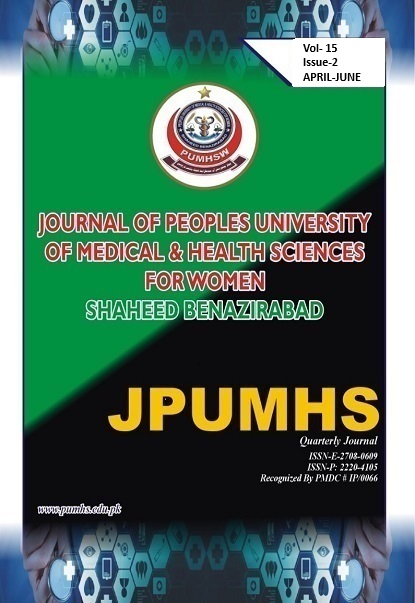HISTOPATHOLOGICAL CORRELATION WITH HELICOBACTER PYLORI IN MALIGNANT AND NON-MALIGNANT GASTROINTESTINAL DISORDERS.
J Peop Univ Med Health Sci. 2025:15(2) ,30-42. http://doi.org/10.46536/jpumhs/2025/15.02.621
Keywords:
Helicobacter pylori, Gastrointestinal Malignancy, Biopsy, Histopathology.Abstract
BACKGROUND: Gastrointestinal (GI) disorders, ranging from benign to malignant, are major global health concerns. Helicobacter pylori infection is a key risk factor for GI diseases, especially gastric cancer. OBJECTIVE: To evaluate the prevalence of malignant and non-malignant gastrointestinal disorders in GI biopsies and to determine the prevalence of H. pylori and its relationship with histopathological findings. METHODS: This retrospective observational study enrolled 363 patients who underwent gastrointestinal biopsies at the Pathology Department of Hayatabad Medical Complex, Peshawar. Histopathological diagnoses were classified as malignant or
non-malignant, with H. pylori presence confirmed through Giemsa staining. SPSS version 26 was used to analyze the associations between H. pylori, patient demographics, and histopathological outcomes using Chi-square tests, with statistical significance set at p<0.05. RESULTS: Among the 363 patients, 88.4% (n=321) presented with non-malignant conditions, with chronic non-specific gastritis being the most frequent (55.3%). Malignant diagnoses accounted for 11.6% (n=42), with adenocarcinoma being the predominant malignancy about 7.7% (n=28). H. pylori infection was detected in 10.2% (n=37) of cases, showing a significant association with non-malignant conditions (p=0.019), particularly in patients aged 19–49 years. However, there was no significant association between H. pylori and malignancy (p=0.225) or with gender (p=0.225). CONCLUSION: This study highlights the predominance of non-malignant GI disorders, with H. pylori infection significantly linked to inflammatory conditions but not to malignancy. Age was a significant factor in H. pylori prevalence, underscoring the importance of age-targeted screening.
Downloads
Downloads
Published
How to Cite
Issue
Section
License

This work is licensed under a Creative Commons Attribution-NoDerivatives 4.0 International License.




